New research offers insights into turtle movements at Ginninderra
Ginninderra has a resident population of Eastern Long-necked Turtles (Chelodina longicollis) that use its dams, pond and creek. Researchers from CSIRO and the University of Canberra have monitored their movements over two summers to get a better understanding of their behaviour.
About the Eastern Long-necked Turtle
The Eastern Long-necked Turtle is a native semi-aquatic freshwater turtle which inhabits a wide range of water bodies in natural and developed environments. They prey on fish, tadpoles, frogs, crustaceans and macroinvertebrates. They are known to move across the landscape to lay eggs or to locate alternative water and food resources. The turtle is a common species which has overall benefitted from the construction of farm dams and water bodies. However, populations have been impacted by fox predation and urbanization.
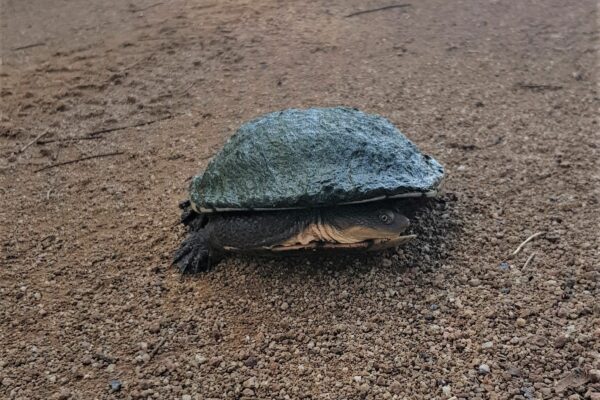
The Eastern Long-necked Turtle.
Turtles at Ginninderra
Most water bodies at CSIRO’s Ginninderra site contain turtle populations. The two main water bodies – a large Farm Dam and Hall’s Pond – are part of the water infrastructure created for farm agricultural activities. Turtles colonised the dams after they were created, most likely from nearby waterways such as Hall’s Creek and Ginninderra Creek.
The research project
The research was undertaken by Micah Davies and Melissa Piper (CSIRO Environment), Alex Drew (CSIRO National Collections and Marine Infrastructure) and Bruno Ferronato (University of Canberra and ACT WaterWatch).
The research team tracked turtles living in the Farm Dam and Hall’s Pond at Ginninderra over the summers of 2019-2020 and 2020-2021. They found a healthy turtle population at the site, capturing and releasing 55 turtles in the first season and 78 turtles in the second season. Captured turtles were weighed, measured, sexed and assessed for general health.
A small number of turtles also had a tracker attached before they were released to monitor their movements. For ethical reasons, turtles could not carry a tracker that comprised more than 5% of their body weight so only turtles that were heavy enough had a tracker attached.
Previous studies had only used radio trackers, which provide basic data about turtle movements between locations. For this study, both radio and GPS (satellite) trackers were used. This provided the team with more details about the exact routes turtles took when moving between locations.

A turtle with a tracker attached.

Four turtles being released into the Farm Dam with trackers attached.
Turtle movements in 2019-2020
During 2019-2020, five female turtles were tracked. Three of these turtles made terrestrial movements that were recorded for at least 30 days, helping identify refuge areas and movement paths.
There were record drought conditions during this season which significantly reduced the water level in the Farm Dam where the turtles were living. It’s likely that these conditions led the turtles to search for a site with less fluctuation in the water levels. As the Farm Dam is an isolated body of water, the turtles would need to move over land to seek an alternative. Turtles were found sheltering under native flora, such as eucalyptus plantings and tagasaste (Chamaecytisus palmensis), along the route that they followed. An increase in turtle movements due to the dry weather is supported by Ginninderra staff recording 96 turtle sightings in summer 2019-2020.
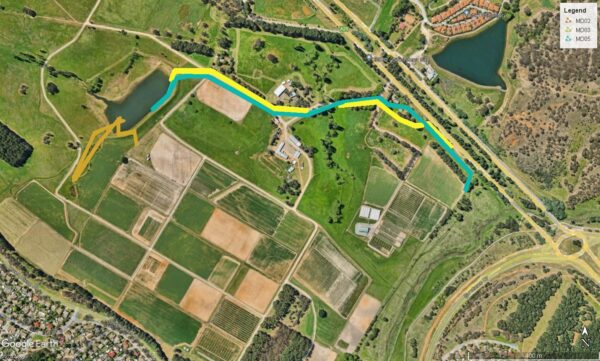
The movements from the Farm Dam of the three turtles that were tracked in 2019-2020. Each turtle is represented by a different colour.
Turtle movements in 2020-2021
During 2020-2021, 26 turtles were tracked from both Hall’s Pond and the Farm Dam – 21 female, 4 male and 1 unknown. Five turtles provided detailed terrestrial movement data, with two moving beyond the property boundary to an adjacent creek. The majority of tracked turtles remained in the water bodies throughout the season. This season was very wet and dam levels were high, meaning that the turtles had improved habitat conditions through increased food availability and water quality. It’s likely that this reduced their movement, as they had less need to seek better conditions elsewhere. This is supported by Ginninderra staff having not seen many turtles on land in 2020-2021.
The wetter La Nina seasonal conditions meant that turtles could move from the Farm Dam towards Ginninderra Creek by following the natural drainage line through waterlogged paddocks. They also moved to a nearby small dam. These movements are different to 2019-2020, with the possibility that the drier conditions meant a suitable path to the creek wasn’t available that season.
A small patch of vegetation between the Farm Dam and small farm dam was used for several days by several turtles in the 2020-2021 season, either as refuge or for aestivation (similar to hibernation). No stops were made by the turtles that crossed an open paddock area, possibly because there was no shelter available.
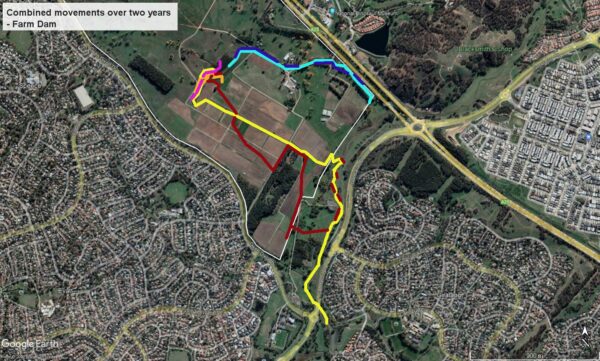
Combined turtle movements from the Farm Dam for 2019-2020 and 2020-2021.
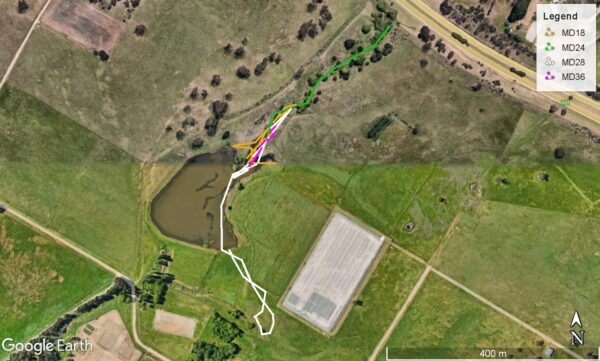
The movements from Hall’s Pond of four turtles that were tracked in 2020-2021.
Overall insights into turtle movements
The active movement of turtles during the dry summer of 2019-2020 compared to their relatively limited movement in the wet summer of 2020-2021 supports previous research findings. Turtles are opportunistic and will seek better habitat conditions if needed or remain where they are if conditions are good.
The difference in movement patterns between the Farm Dam (overland, relatively long) compared to Hall’s Pond (in stream or short overland) suggests turtles from Hall’s Pond don’t need to make terrestrial movements because they can remain in the pond or creek and use the creek to access other wetlands if required. By comparison, turtles from the non-connected Farm Dam need to make overland movements to reach other aquatic habitats.
The use of shelter by turtles in both seasons suggests that they will use shelter when it is available, reducing the threat of exposure from hyperthermia and dehydration, and helping protect them from predators. They were also able to safely travel 200m from the Farm Dam to the small farm dam in 2020-21. This distance could potentially help determine a recommended maximum distance between refugia for turtles. The GPS tracker data shows that most turtle movements occurred in the evening. Movements out of dams occurred when the temperature was around 20°C and the relative humidity was over 50%.
Next steps
Although the dataset from the study was small, it offered some good insights into the behaviour of turtles at Ginninderra. The learnings from using the trackers will also help inform how this equipment can be better utilised in future turtle research.
The project expanded on previous research to confirm the water bodies at Ginninderra are an important habitat for this native turtle and added new and detailed data on exact movement pathways between habitats which are essential to the management of this species.
The findings will be used to inform our ongoing site management and future environmental planning for Ginninderra. The research team are also planning to prepare the findings for publication in a scientific journal.
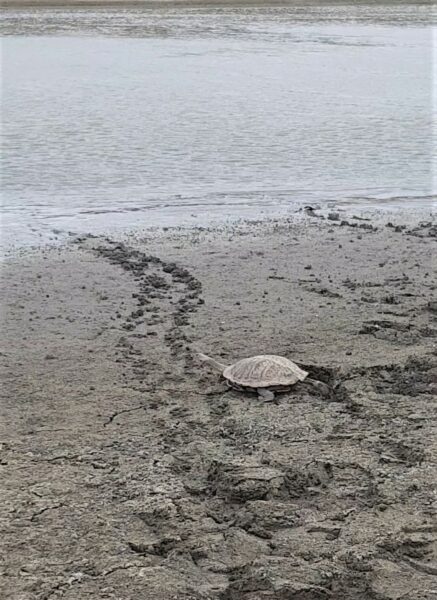
A turtle heads for water at Ginninderra.
